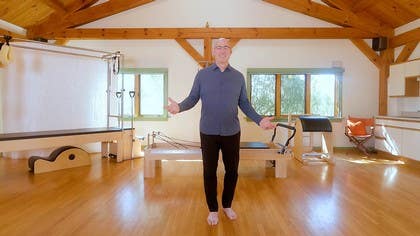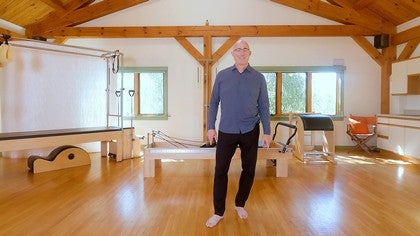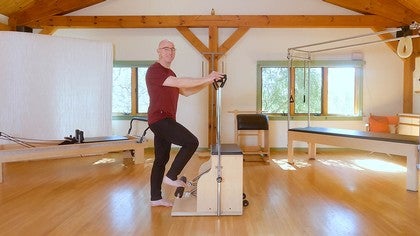Discussion #4466
Hip Replacement Preparation
Description
Note: From about 20:57-22:42 there are images from Brent's surgery shown.
About This Video
Transcript
Read Full Transcript
So you're thinking about a new hip? Well, I had that dilemma a number of years ago and have been dealing with hip pain personally in my life for over 20 years and had to go through the painstaking process of discovering what type of hip and when I needed the hip replacement. So, that's what I hope to do today in this first lecture. It's to discuss with you and those listening, how do we prepare, how do we know if it's our time to have a hip replacement? I do want to make a little disclaimer right away and that is that this is in relationship to my experience with my surgeon in my rehabilitation and every case is unique just like every one of our clients is unique and should seek professional advice.
I'd like to start off with asking the simple question, is it time for me to take the next step? And that next step that we're referring to today is a total hip replacement. And I think this is something that we all deal with in many different ways if you've been dealing with hip pathology and hip pain, the same would be true for those of you dealing with knee pain or knee pathology, it's asking the question, is it my time? So, I hope to be able to go through in detail and talk about that. I wanna cover a couple other things before we go there.
Number one, I want to make it very clear that today in medicine, we are the consumer. So, that means that we get to ask the questions, we get to interview the doctors, we buy the insurance and we really are the consumer and I know sometimes in the old school medicine, we don't feel like it, We feel like it's an authoritative community but really you are the one that's able to shop and to look into investigate and be an educated consumer. The other thing that is interesting to me is this idea that I wanna share with you called false positives. There are many things that cause symptoms. Let me use the spine for example.
If we took a thousand people who had never had spine pain and we did an MRI of all of them, we would find that a very high percentage of them have the same pathologies that people are being diagnosed with that have back pain even though they don't have any back pain. That's referred to as a false positive and this occurs in every pathology or every diagnosis in the healthcare industry. We try to be very careful and we try to have a number of tests and a number of situations to understand. So, how would you avoid something like a false positive? And I think this also is something we'll talk a little bit more about, it's understanding.
The more we understand, the more we can make an educated decision on that. And then I want to talk a little bit about what is the best prosthesis for you if you decide to do that. And how do you pick the procedure? So, we're gonna go through my example in a few minutes of exactly what I did interviewing doctors and doing my research and hopefully encourage you if you're in that situation that you're able to do your research. What is a minimally invasive surgery for example that we're hearing a lot about where these different types of orthopedic surgeries used to be major, open surgeries.
And then, we're% going to talk about the longterm comparison between some of these different procedures and the short term outcomes. How fast do I get back to work? Do I have any precautions or contraindications? And the last thing is looking at how do I pick a surgeon? So let's get started.
First is question, is it time to get my hip replaced? And this is a question I get asked all the time especially in the Pilates community. For some reason, many of us that were retired dancers do have hip pathology. Some of that is due to the nature of the bodies that are attracted to dance that might have hip dysplasia or shallow acid tablets, labral tears, hip impingement and then just good old degenerative joint disease that a lot of us have if you been dancing or doing really strenuous activities for many years. The key question that I asked my clients is, are you limited more than 50% in the activities that you desire to participate in?
I think this is a really important question. I used to say 80% but with today's advances in hip replacements, I would put it down to 50%. If your life has compromised 50%, any activities you choose to participate in, you might be a good candidate for further evaluation of a hip replacement. Another key factor I look at in making this decision of whether it's time or not is the tolerance that I have with basic things like sit to stand and stand to sit, getting in and out of cars, getting up off the ground, getting in and out of the mermaid position and if you're someone that is finding that you just have less and less tolerance for these types of positions and really normal activities putting on your pants, putting on shoes and socks, "I'm unable to squat." Again, that's another key factor telling me that your daily activities now are being limited because of the hip pain. And this might be another reason to pursue more investigation.
Another one that I always tell people is just the ability to simply squat. So, a lot of people have lost the ability to squat and so they start compensating and the compensation often comes by moving through your low back or putting additional stress on your knees. So, it's not uncommon for those of us that have a hip pathology to also have other injuries because of the hip in our lumbar spine, in our knees and in our feet. So, we'll talk a little bit more about that later. Another key factor I look at is the nonsteroidal anti-inflammatory.
So things like the ibuprofen and the Naprosyn, the Aleve, diclofenac acid, all of these non-steroidal anti-inflammatories that they no longer are really working. It used to be that you would take one or two a day, now you could take three or four a day and still not really cutting the edge, that's a good sign that the degeneration and the pain is worth or wants more investigation. After you seek a medical doctor and you wanna get a little more information, you're going to get an X-ray and the X-ray should be confirming the symptoms you have. This is why I don't tell people just go around and get an X-ray because they might have a little hip tendonitis. Even though the X-ray might show degeneration, they are not candidates for a total hip replacement.
I'm going to repeat that. That is the false positive. Somebody who has a tendonitis goes and gets an X-ray and it shows degenerative changes, all of a sudden you want to switch your diagnosis from a tendonitis of the psoas tendon to a degenerative joint disease where one can be treated with some simple rest and physical therapy and anti-inflammatory and some exercises and the other one requires a total hip replacement, a major intervention. So again, being careful to make sure that the X-ray and the imaging is confirming the signs and the symptoms, right. So that's a very important one.
And then, I think the last one is sometimes people are so fast. If you go to a surgeon, a surgeon does surgery. So if you go to a surgeon and you have confirmed x-ray findings, they're gonna wanna do surgery on your hip typically. But I would say, don't do that until you've exhausted other forms of intervention that could be physical therapy. It might be some PRP injections, it might be some stem cells that you might be somebody that responds well.
It's like a 50% of people that try some of those things at that early stage of degeneration actually do better and don't need total hip replacement so early. And then mainly to look at all those factors, weigh 'em out, look at the inconvenience of your life or not and then you make a decision, "Yes, I'm going to get my hip replaced. It's time for me to take that action." So, here's the slight of me contemplating a new hip after meeting with an orthopedic surgeon in Chicago and I respect him highly and I've been dealing with my own hip pain for years and years. And my original hip pain goes back to a water skiing accident in my twenties and then a reoccurring accident of tearing the labrum about 20 years later in the right hip. And at that point in time, I ended up having an arthroscopic procedure and then 20 years after that, I was warrantying a total hip replacement.
So, this is me coming in the airplane a little sad realizing that I need to have a hip replaced. And the thought that kept going through my mind is how doctors influence us, and I want to be very clear about this. Yes, the doctor said, "There is no other way." And I remember thinking to me with this concept of whole body health and I kept thinking is whole body health defined as me having my whole body or is it me being able to participate wholly in life? And so, that question of to be whole or not to be, that was a question that was very challenging for me and I finally came to the conclusion that the limitations far exceeded this idea of me hanging on to all of my body parts originally and realizing that I truly want to participate and this particular hip was not allowing me to participate fully in life. So at that point in time, my X-rays, as you can see here, this is looking at the right hip and there should be a really dark line just around the top of the hip there, you see the yellow line?
It represents that there is no cartilage, it's bone to bone, there's bone spurs and even some microfractures and sclerosing in the acetabulum has been so long. And just to give you a little personal history on my case, it's that I had had a unique procedure with the arthroscopic where they did microfractures and they also did something called a thermal shrinkage which they no longer do because it tends to have more adverse effects than good effects. The intention was good to shrink the capsule after it had been injured but the idea was that it now scarred the capsule down and caused the sclerosing of the capsule and stuck the capsule to the actual bone which was a reason why I couldn't get the fluxion in my hip because the capsule was stuck onto the femur. And so then when I'd go into flection, that would be restricted. The movement then would immediately go into my back and so my back was giving me just as much trouble as my hip was.
You can sort of see that in this X-ray. The next process in knowing that, "Okay, I need to have this hip replacement, I've dealt with it long enough, it's confirmed with X-ray and now I'm ready to start investigating types of procedures." And it really comes down to two types of procedures. The first one here is a slide of a posterior access procedure. This was the most common procedure for decades and most of the people that are elderly that had a hip replacement even more than 10 years ago probably had a posterior approach. There's still a lot of surgeons that are continuing to do a posterior approach because the rule typically is a surgeon becomes comfortable with a procedure and they do thousands of them and it's best that they continue to do that to have the best outcomes.
There's many people with posterior approaches that have had very successful outcomes. However, they do have some limitations. Some of the older limitations of the posterior approach was the risk of subluxing or dislocating after the surgery with a hip flection abduction and internal rotation. And then that particular motion would put the posterior capsule at risk and if you fell down or twisted your leg, you would have a risk of dislocating the hip. And this is interesting because in Pilates, we often had for many years and obviously in physical therapy, the contraindication and risk of asking our clients to go into those combined planes of motion movement.
So again, posterior approach limitation, hip flection, abduction, internal rotation, that's because that's exactly the position they put you in to be able to replace the hip. The other thing that's interesting to note in this surgery and I hear the surgeon saying they're doing a lot better job in using oversize hips and they're now reattaching some of the muscles. But you have to think of the population that had hip replacements was more people over 70 and now there's a huge number of us having hip replacements that are in our 50s and 60s. And so, the tissues are very different in somebody like myself, 50 years old or 55 years old when I had the surgery and somebody who's 75 years old. And so, some of the surgeons say that there's not enough mass in those muscles to be able to actually reattach them and they just close up the capsule and they typically do not have, or regain the nice external rotation strength that we would expect or other muscles can supplement and help out.
So, that's a condition that I'm always curious about, it's people that lose the external rotation which is what hurts us in deceleration in our movement. I had a case that was very interesting. She had come to me to prep her for bilateral knee replacements. And when she came to me, her knees were severely knocked and valgus and very weak. She was in her seventies.
And as I was taking her history, I was asking her, "Tell me a little bit about what's going on and when did you start noticing the knee pain." and et cetera, et cetera and it turns out that she had had bilateral hip replacements simultaneously five years prior. Both posterior approaches. And I asked her, "Who did your physical therapy?" She said she didn't have physical therapy. So, I want you to imagine that if both of my external rotators had been cut with the surgery and I had a walker. You might imagine me walking without external rotation where the knees knock.
And if I walk like that long enough, pretty soon I'm going to end up doing harm to the knees. So here, this patient of mine had never done rehabilitation, went from the Walker into a valgus gate and I recognize this when I actually put her on the reformer and started doing just some basic footwork and realize that she could align her knees just fine with two reds and a blue spring but couldn't do it in standing. So, we immediately put her on a hip strengthening program that resulted in the knee pain reducing by about 80% and her not needing to have total knee replacements. So, I think it's very important that whether you choose the posterior or the anterior approach, that we really do rehabilitate the strength of those hips so that we don't affect other joints as was the case in this particular lady. This next slide is looking at the anterior approach.
And so, this one's interesting in that the dissection does not cut any muscles. They call it minimally invasive. And they basically take that tensor fascia latae and they separate it from the hip and the gluteus muscles so that they have visibility down into the capsule. So, there's no horizontal cuts on any of the muscle fibers. It's merely a dissection so all the muscles stay intact.
That's a very big plus in the anterior and anterior lateral approach. And then they go in and they remove the head of the femur from this position and replace it with a new head and a stem and a new acetabulum. So, the components often are very similar now between the anterior and the posterior. It might have to do more with the approach. And again like I said, the approach could be more about the physician's experience and what they're most comfortable with.
And if you're comfortable with that physician, you're likely to get a better result than asking a physician to do a different procedure on you that they're not familiar with. So, this slide shows some of the different prosthetic pieces and so this is another big concern that we shop out and we want to know if we put titanium and metal inside of our bodies, does that titanium leech into our blood and into our system? We hear people talking about a metallic poisoning and toxicity. And so, they've really worked hard to try to find materials that have the least amount of leaching that are the most like the natural hip and there's a combination of these products. So, there is the titanium and the metal high breeds, the polyethylene, the heads can be ceramic or they can be titanium and then your femoral stems can either be porous without cement or they can be cemented.
And what we tend to find now is that we're seeing more and more people going with a combination of that, with a ceramic head going into a nylon liner that's inside the acetabulum, that fits into a titanium cup and a titanium stem and there is seemingly more in research showing that the porous non-cement stem is better. The other thing that's interesting that has been noticed is that some of the surgeons are using robotics to be able to bore out the femur to get a perfect fit down to the micrometer of the femoral stem. So again, being up to date and finding out what surgeons doing what and what hardware's they're using and what you'll feel most comfortable with. I remember having a patient that had a ceramic on ceramic and it felt great but they squeaked when they sat down. So, there was always a squeak that was just between the ceramic and ceramic.
So now, we're seeing them using more diverse materials where you have the ceramic onto the polyethylene bushing that's inside of the titanium cup or something like that and I've never heard any squeaking or any kind of weird sounds coming out of my hip since I've had my hip replacement. Another important thing is the procedure that they're doing. So, I obviously chose the anterior lateral approach into your medial approach and there's a table that they use called the Hanna table. And the HANA table was designed to deal with leg fractures, traumatic leg fractures and they could position the leg in any positions. So, you can imagine somebody that had a multi level fracture in the femur from a car accident or motorcycle accident.
As they're putting an intramedullary rod into the leg, this allowed the surgeon to move the table or the leg in a way that they could line up the rod to go into that femur. Well, Dr. Matta, who was a very famous orthopedic surgeon for hip replacement and has the Matta procedure that I have been trained, has trained many, many surgeons around the world uses this table. And so, now this table is becoming more and more popular. Many of the orthopedic hospitals are using the Hanna table not just for traumatic repairs, orthopedic repairs but also for total hip replacements. So, what allows them to do is once they have opened the joint and they can see it, now they can position the femur in a way that they can remove the head of the femur and then they can move the leg out of the way and have full access to be able to get the acetabulum and place the new one and then put the femur and the femoral stem in and then they can lift that leg back up mechanically and without hurting the surgeon have great precision in giving you alignment and closing the back up.
So, it's been a great advent and allowing surgeons to move quickly to have a lot more accuracy and consistency in the delivery of the surgery. So, here's the surgery that I had. This was basically doing that anterior opening. What you're looking at there is the muscle bed and that muscle bed is the tensor fascia latae and the glute amidst and a little bit of the rectus femoris. And as they dissect in this next slide, they actually go down inside and are able to remove the arthritic head of the femur, okay.
And in the next slide, I know it's a little gory, I don't want it to be too gory but this is where the table now has bent down and moved the leg out of the way and the surgeon now has a very clear view of being able to insert that new acetabulum much more accurately, not just by feel but they can do it with a combination of X-ray and visibility to be able to get that in a very accurate place. And then they test a number of different femoral heads and stems to be able to get it so that it has perfect alignment now with where you want the leg length to be. One of the common problems in old age total hip replacement was a lot of people would end up with a leg length discrepancy following the surgery. So, their leg would either be a little bit longer, a little bit shorter based on the judgment of the surgeon and the stem or the ball and socket that they had and now they can control the angles and the precision is really amazing on some of the new techniques and new procedures. And then here's an example of the ceramic head on top of the femoral stem and that's being now inserted down into the femoral neck.
And then you can see that now the last piece here is picking your surgeon. So I the picture of my surgeon up here, this is a Juan Carlos Suarez in Miami and we've since become very good friends as well. And I went everywhere. I went to New York, I went to Chicago, I interviewed surgeons, I am going to Colorado where Dr. Matta is himself even though he's sort of retired, I'm out to California down to Austin, and I interviewed a lot of different surgeons. And what it really came down to was how many surgeries have you performed in this particular technique?
hundreds or thousands? Did you perform this surgery with a well-respected surgical central hospital? So, I know some surgeons work in some places that have a higher infection rate or don't have a full time staff like I love the idea of knowing that the people that are working with my surgeon are people that work with him every day or with her every day. The idea of knowing that they have different people coming in in the surgical staff, not so interesting me. Choose a non-opioid practitioner.
So, a lot of times, some of these orthopedic surgeons are still using really strong opioids as part of their treatment plan after surgery and I am a big advocate against, or I should say I'm a big opponent to the use of opioids whenever possible. They tend to create much more problems and I'll share more of what my surgical procedure was as we go through this. And I was fortunate to have a surgeon who also didn't believe in opioids and with that, we were able to use other types of pharmacology to be able to minimize the event and I basically had zero pain that I could complain of even in the hospital and coming home I was on nothing stronger than Tylenol. So, I think it's important to understand that our body can be prepared and I'm going to do a whole section in this series for the course, talking about pain and overcoming the fear of pain and realizing that we don't have to have much pain if we're working closely with a surgeon in the pharmaceutical management of the surgery and the after surgery. Another biggie for me is that the physician believes in therapy.
There are a lot of surgeons who believe that they're God and that after a surgery you're done, you don't need any therapy as a particularly case that I shared with you earlier. I think that a doctor that's willing to work with other practitioners in the healthcare field, is going to provide a much more well-rounded and holistic health for you. And that believe in therapy is an important part of recovering from these total joint replacements. The last couple ones here is one is treating you like a human, and I'll tell you this was the last thing I had it down to about four surgeons and I was really excited knowing that these four surgeons were all just leaders in their field, very capable, two of them didn't take my insurance so in that case, I got rid of them and that would have been a $30,000 out of my pocket surgery. And two of them were in my insurance plan and the last tipping point was as I sat down in Dr. Suarez's office, he sat down next to me and he asked me what I felt I should do and he was asking me if I felt I was ready while all of the other surgeons told me I was ready and told me what I needed rather than asking me.
And I felt that that openness after he had met all my criteria was the key for me to choose Dr. Suarez as my surgeon and I think this is as I mentioned early on very important for us to take it serious that we're the consumer and that we can interview and meet with these different doctors and find someone we're comfortable with that we can ever pour with. On another note, great surgeons are great surgeons. They don't have to be great communicators. So, you might find that some of these guys are doing thousands of the surgeries and they have a great team and they have all the things they just don't have the great bedside manner, that's okay too as long as you've ruled out that maybe they have an assistant or a PA or somebody else on their team that does have good bedside manner that you can contact and communicate with when you need to after surgery. And a lot of times we go home from surgery and even for me going home and thinking there were still some things that I had questions about which I hope to answer as we go through this course about what I could do and what I couldn't do.
And I'm a physical therapist, I should know but the reality is every surgeon is different and they know what they did inside the hip and every case is different and I'll explain that a little bit too. So, I want to basically say that here's my decision, right. I decided to do an anterior total hip replacement June of 2019. I chose Dr. Suarez in Miami using the Matta procedure on the Hanna table and I chose a ceramic and titanium component with a nylon bushing, no squeaks and no metal flakes in the bloodstream and non summit and so that was my choice based on all the criteria that I had made. This concludes the first module and I hope that it gives you some good advice, some helpful hints on how you can best prepare while making this difficult decision.
Me and My New Hip: with Brent Anderson
Comments
You need to be a subscriber to post a comment.
Please Log In or Create an Account to start your free trial.
























